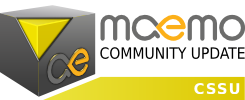 |
|
2007-11-12
, 15:17
|
|
Posts: 772 |
Thanked: 183 times |
Joined on Jul 2005
@ Montclair, NJ (NYC suburbs)
|
#1
|
| The Following User Says Thank You to RogerS For This Useful Post: | ||
|
|
2007-11-12
, 16:38
|
|
|
Posts: 165 |
Thanked: 9 times |
Joined on Jul 2007
|
#2
|
That sounds great Roger, and makes me want to take a look at Mozilla and XUL again (last time I looked at XUL, it was new, and the API kept changing). Unfortunately, unless something has changed, I doubt XUL will make it to the IT platform, as their <=400MHz processors just don't have the power to interpret XUL fast enough to make it an effective UI.
|
|
2007-11-12
, 19:14
|
|
|
Posts: 11,700 |
Thanked: 10,045 times |
Joined on Jun 2006
@ North Texas, USA
|
#3
|
Very, VERY nice work! That's what the internet is for!
__________________
Nokia Developer Champion
Different <> Wrong | Listen - Judgment = Progress | People + Trust = Success
My personal site: http://texrat.net
Nokia Developer Champion
Different <> Wrong | Listen - Judgment = Progress | People + Trust = Success
My personal site: http://texrat.net
|
|
2007-11-12
, 21:48
|
|
|
Posts: 772 |
Thanked: 183 times |
Joined on Jul 2005
@ Montclair, NJ (NYC suburbs)
|
#4
|
Originally Posted by Traecer

Well, in the current state of things, you must be right.
Unfortunately, unless something has changed, I doubt XUL will make it to the IT platform, as their <=400MHz processors just don't have the power to interpret XUL fast enough to make it an effective UI.
But processors get faster, and who knows? Maybe some way to compile XUL into something more compact will come along.
Makes me curious as to whether MicroB's UI was built entirely by hand or whether there was a XUL to Hildon tool to do some of the work . . .
Thank you for the compliment. I want to give credit to the developers whose work I built on, but I'm reminded too of what a friend told me: "Magicians don't invent every magic trick they do." So in that regard I appreciate your appreciation.
__________________
N900 Guide Brief intro to the Nokia N900 (http://n900guide.com/)
Maemoan since July 2005 )
N900 Guide Brief intro to the Nokia N900 (http://n900guide.com/)
Maemoan since July 2005 )
|
|
2007-11-12
, 22:07
|
|
|
Posts: 165 |
Thanked: 9 times |
Joined on Jul 2007
|
#5
|
Well, at the risk of starting a flamewar with the Javaistas, that's what happened with Java. Java was an absolute dog on ~200MHz processors when it was released. Somewhere in the 500-800Mhz range Java apps became usable, and on today's Ghz+ machines the difference between native and Java apps is unnoticeable except for some occasional UI oddities. OTOH, the Java VM and associated tools matured a lot during that time as well, and cut down versions like ME appeared for low-power devices. So some sort of super-speedy XUL interpreter isn't out of the question, but I do agree that it won't make a difference when our tablets all have 800MHz+ processors.
|
|
2007-11-13
, 09:37
|
|
|
Posts: 1,463 |
Thanked: 81 times |
Joined on Oct 2005
@ UK
|
#6
|
Nope: the browser application (i.e. the UI) is separate to the engine. This allows Opera, WebKit and Mozilla-based engines to display the page within the application container provided. This is what's Hildon-specific and why when using Opera, the UI is identical to that used in microb.
| The Following User Says Thank You to aflegg For This Useful Post: | ||
|
|
2010-01-09
, 08:51
|
|
Posts: 19 |
Thanked: 0 times |
Joined on Jan 2010
@ USA
|
#7
|
I know this is old treat .. but i dont want to create new one just because i ask a single question .. Can i get this add on for Nokia N900 ? .. do i need to install khmeros font to support khmer language if so, how do i install font to Nokia N900, i am really noob to Linux ( win user ) ..








